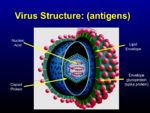Viral Structure
Revision as of 12:55, 17 May 2010 by Bara (talk | contribs) (Created page with 'thumb|right|150px|Virus Structure - B. Catchpole, RVC 2008 Outside the host cell, viruses exist as particles known as virions, consisting essentiall…')
Outside the host cell, viruses exist as particles known as virions, consisting essentially of the virus genome, packaged in a 'capsid,' and a lipid component, which contains proteins that aid entry into the host cell. Viruses can be classified as either:
- Naked- these contain only RNA/DNA and a protein coat
- Enveloped- as well as the RNA/DNA and protein coat, these viruses have a lipid-based membrane
Virus genome: Composed of either RNA or DNA- identification of viruses can be established by testing susceptibility to a ribonuclease or deoxyribonuclease
- Each nucleic acid is either single stranded or double stranded
- Nucleic acids can be either linear (free 3' and 5' ends) or circular (strands are covalently closed)
- Viral genomes can range from 1.7 kilobases (e.g. Porcine circovirus) to over 1200 kilobases (e.g. Mimivirus)
- The genes of some viruses are segmented, coded by two or more nucleic acid fragments, e.g. influenza virus
Viral proteins: Proteins that make up virions are usually structural proteins, used for:
- Protection of the genome
- Attachment to host cell
- Fusion of envelope to host cell membrane
- Non-structural proteins:
- enzymes, e.g. reverse transcriptase
- primers
- transcription factors
Capsids
This is the protein coat that surrounds the genome, and is responsible not only for genome protection but also recognition and attachment to the host cell
- Form symmetrical structures, e.g. helix, icosahedron, rod, cone
Membranes:
- Most viruses have a lipid membrane. If present at the surface, the membrane is known as the 'envelope'. Several viruses keep the lipid membrane within themselves
- Often associated with proteins such as glycoproteins- these often aid the fusion process

